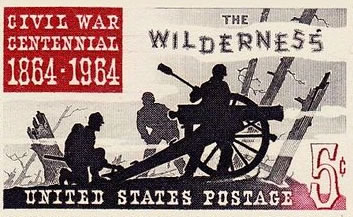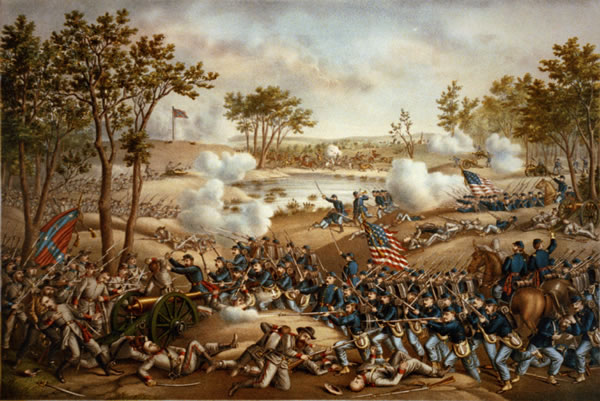INTRODUCTION
The Overland Campaign, sometimes called the Wilderness Campaign, was a series of battles throughout Virginia in 1864 initiated by Union Commander Ulysses S. Grant to destroy Lee's Army of Northern Virginia and to eventually take the Confederate capital of Richmond. Grant would attempt to accomplish this by placing his massive army in between Lee's army and Richmond. Three massive battles and dozens of skirmishes characterized the bloody Overland Campaign. In the two months in which the Overland Campaign took place, combined casualties approached 73,000, though the Confederates suffered a much higher percentage of casualties. In the end, the repeated Union assaults on Lee's Army took a major toll and drove his army to the brink of disaster at Petersburg.
WILDERNESS

On May 5, 1864, Confederate and Union forces clashed in a virtually impenetrable tangle of undergrowth and dense forests near the Chancellorsville battlefield called the Wilderness. Grant had attempted to move his massive army east and south of the region to avoid confrontation in such a foreboding setting, but Lee moved two divisions of his army toward the Wilderness to intercept him. Fierce fighting ensued for two days through the forests and undergrowth, some of which caught fire. By the end of the fighting, nearly 29,000 total casualties were recorded, 17,666 of which were incurred by the Union Army.
SPOTSYLVANIA COURTHOUSE
Despite the high number of casualties at the Wilderness, Grant shifted his troops toward the southeast away toward Spotsylvania Courthouse in the attempt to put his army between Lee's and Richmond. Unfortunately for Grant, Lee's army arrived at Spotsylvania first and built entrenchments. The Battle of Spotsylvania Courthouse was a violent on and off affair that lasted for nearly two weeks. One of the most dramatic events of the battle occurred at "bloody angle" where numerous Union assaults were repulsed by Lee's Army at a bend in the trenches on May 12. Here, Union and Confederate soldiers fought in hand-to-hand combat for almost 24 hours. In all, over 32,000 casualties were recorded at Spotsylvania Courthouse, the highest casualty count of the Overland Campaign. On May 21st, Union General Ulysses S. Grant suspended operations and moved his army southeast. While both armies were incurring significant casualties, Lee's Army was incurring a greater percentage of casualties.
COLD HARBOR

After numerous skirmishes through central Virginia, Confederate and Union forces engaged in large-scale warfare again on May 31, 1864, at Cold Harbor, only ten miles from Richmond. In the battle, both the Union and Confederate armies were heavily reinforced, and the Confederates managed to build a series of airtight fortifications that extended for seven miles. On June 3rd, Union forces under Ulysses. S. Grant attacked the fortifications on the Confederate right and were thoroughly routed. Grant regretted his decision to attack at Cold Harbor and admitted that nothing was gained from the thousands that died. He also feared that the Confederate defensive victory at Cold Harbor may have given the Confederates enough hope to continue fighting, whereas he was sure their will to fight was dwindling previous to Cold Harbor. In all, Grant lost nearly 13,000 soldiers at Cold Harbor, compared to less than 6,000 on the Confederate side. Furthermore, Grant's defeat and high casualty numbers contributed to anti-war sentiments in the North. Lee's victory at Cold Harbor, however, would be his last in the entire war. Despite the Confederate victory, Lee had no choice but devote all of his dwindling defenses to Richmond and Petersburg.
After the devastation at Cold Harbor, Grant moved his army across the James River between June 12 and June 18th to prepare an assault on Petersburg, which served as a crucial railroad junction as well as the main supply line to Richmond. With this departure in strategy from Grant, from the original objective to destroy the Army of Northern Virginia, to a more patient and political approach to starve the enemy, Lee realized his army would fall under siege and was likely doomed. The beginning of the end had arrived for the Confederacy. |